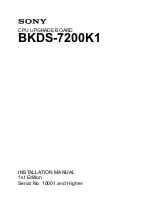
OPTIMOD
TROUBLESHOOTING
5-5
The five-band structure does not have a Loudness Controller because its “automatic re-
equalization” function makes spectral balances (and, therefore, loudness) more consis-
tent without the need for a special loudness controller function.
Inconsistent Levels (DTV Applications)
The release time setting in the two-band or five-band compressor determines the speed at
which the 6200 corrects program material with excessively low levels. If the 6200 seems
to take too long to correct low levels, speed up the release time of the compressor.
Also, the
GATE THR
control is set quite high in the DTV-oriented presets to prevent
noise, low-level FX, and underscoring from pumping up unnaturally. This means that it
is important to set the reference level control (in the appropriate Setup I/O Calib screen)
correctly, so that the presets operate in the range for which they were designed. (See Sec-
tion 2 for instructions on setting these controls — there is one for the analog input and
one for the digital input.) If the reference level is set too high, the gate will frequently be
on even when program material has normal levels. It will therefore inhibit the ability of
the processor to quickly correct material that is slightly too low in level.
Incorrect Lip Sync (DTV Applications)
The 6200 has the ability to add delay so that the total delay through the unit is exactly
one frame of various standards, including 24, 25, and 30 frames per second. It is usually
wise to set the 6200’s throughput delay so that it is exactly one frame, and then add one
frame of video delay to compensate. (The minimum delay through the 6200 is about one-
half frame.)
Multi-frame lip sync problems are not caused by the 6200 and cannot be corrected by it.
Troubleshooting IC Opamps
IC opamps are operated such that the characteristics of their associated circuits are es-
sentially independent of IC characteristics and dependent only on external feedback
components. The feedback forces the voltage at the (–) input terminal to be extremely
close to the voltage at the (+) input terminal. Therefore, if you measure more than a few
millivolts difference between these two terminals, the IC is probably bad.
Exceptions are opamps used without feedback (as comparators) and opamps with outputs
that have been saturated due to excessive input voltage because of a defect in an earlier
stage. However, if an opamp's (+) input is more positive than its (–) input, yet the output
of the IC is sitting at –14 volts, the IC is almost certainly bad.
The same holds true if the above polarities are reversed. Because the characteristics of
the 6200's circuitry are essentially independent of IC opamp characteristics, an opamp
can usually be replaced without recalibration.
Summary of Contents for OPTIMOD 6200
Page 1: ...Operating Manual OPTIMOD 6200 6200S Digital Audio Processor...
Page 6: ......
Page 7: ...Operating Manual OPTIMOD 6200 6200S Digital Audio Processor...
Page 42: ......
Page 80: ......
Page 142: ...5 8 TROUBLESHOOTING Orban Model 6200 This Page Intentionally Left Blank...
Page 170: ...6 28 TECHNICAL DATA Orban Model 6200...
Page 173: ...OPTIMOD This Page Intentionally Left Blank...
Page 175: ...OPTIMOD TECHNICAL DATA 6 33 PCB ASSEMBLY MAIN 1 98 1 98 1 98 32020 000 03 1 of 1 6200 FC CB CB...
Page 181: ...OPTIMOD TECHNICAL DATA 6 39 SCHEMATIC DSP 2 1 98 1 98 1 98 62020 000 04 6 of 7 6200 FC CB CB...
Page 183: ...OPTIMOD TECHNICAL DATA 6 41 PCA DISPLAY 6200 1 98 1 98 1 98 32016 000 01 1 of 1 6200 FC CB CB...
Page 191: ...OPTIMOD TECHNICAL DATA 6 49...
Page 194: ......
Page 195: ...OPTIMOD DAB TECHNICAL DATA 6 53...















































